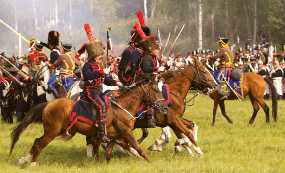Four Belarusian historical-patriotic clubs take part in Borodino Battle 2014
Napoleon’s contemporaries noted that the French Commander said after the Battle of Borodino: ‘The battle near Moscow was the most dreadful for me…’ On September 8th, all those years ago, the Russian and French armies faced one another, commencing battle at sunrise. Little might Napoleon have guessed that the bloody events of that time have been repeated almost annually near Borodino since the mid-19th century.
 Recently, historical-patriotic clubs from Russia, Belarus, Kazakhstan and Lithuania gathered, 125km from Moscow. This year’s event marked the 202nd anniversary of the Battle of Borodino and the 175th jubilee of the State Borodino Military-Historical Museum-Reserve. The museum’s Head of PR, Natalia Kotlyarskaya, tells us that around 50 historical-patriotic clubs took part: including Belarusian Leyb-Eskadron (of the Grodno Hussar Regiment); Berezina 1812 (from Minsk); Brest’s Grenada; and Minsk’s Zolotaya Shpora (Golden Spur) Equestrian-Historical Club (fighting on the French side). Around 1,500 ‘infantrymen’, ‘hussars’, ‘artillerymen’ and ‘dragoons’ re-enacted the terrible battle, with horses and men clashing.
Recently, historical-patriotic clubs from Russia, Belarus, Kazakhstan and Lithuania gathered, 125km from Moscow. This year’s event marked the 202nd anniversary of the Battle of Borodino and the 175th jubilee of the State Borodino Military-Historical Museum-Reserve. The museum’s Head of PR, Natalia Kotlyarskaya, tells us that around 50 historical-patriotic clubs took part: including Belarusian Leyb-Eskadron (of the Grodno Hussar Regiment); Berezina 1812 (from Minsk); Brest’s Grenada; and Minsk’s Zolotaya Shpora (Golden Spur) Equestrian-Historical Club (fighting on the French side). Around 1,500 ‘infantrymen’, ‘hussars’, ‘artillerymen’ and ‘dragoons’ re-enacted the terrible battle, with horses and men clashing.Those watching numbered 33,000 — seated in special stands and on the surrounding hills. Two years ago, (when the Battle of Borodino celebrated its 200th anniversary), the site gathered four times this number. Nevertheless, this year’s fight was impressive in scale. Historically, the event is known as the bloodiest fight of the 19th century, involving over 300,000 soldiers. Every hour, 8,500 Russians and French were killed and many divisions lost most of their soldiers.
Happily, nobody was killed this time. Wreaths were laid at the command points of Field-Marshal Kutuzov (near the village of Gorki) and of Napoleon (near Shevardino), as well as at a monument honouring Raevsky’s squadron. In addition, honours were bestowed upon heroes of the 1812 Patriotic War by members of participating clubs: during a solemn formation, they bowed to cherish the memory of the dead.
The ‘battle’ began at 2pm and lasted for around two hours, featuring a hundred horses and 20 artillery guns. The authenticity of the event is staggering, with each uniform being carefully hand sewn and ‘weapons’ and ‘guns’ being close replicas. A parade of military-historical clubs closed the day, with prizes awarded to the brightest participants.
As the Russian Military-Historical Society notes, the Major in Minor: Borodino Battle in Historical Relics and Miniatures exhibition was a highlight of the gathering, featuring miniature ‘souvenirs’ of the battle: postcards, stamps, matchbox labels, toys, badges and tin soldiers. Almost a million such mini-warriors were on show, enabling everyone to study the ‘battle of giants’ in detail (as Borodino was named by its contemporaries). Among other exhibits were miniature guns, cast-iron cannon balls and lead bullets — discovered on the battlefield and on loan from the Borodino Museum Fund, the Borodino Battle Museum-Panorama and private collectors.
The same day, Borodino Monastery performed a liturgy. Afterwards, participants went to Raevsky’s squadron burial place (passing through the village of Semenovskaya) for a requiem service.
According to various sources, the Russian Army lost 40-45,000 soldiers in the Battle of Borodino, against 30-58,000 French soldiers. The first reconstruction of the kind took place in 1839, under the initiative of Emperor Nikolay I. Interestingly, the average height of those Russian and French ‘bogatyrs’ (as they were named by poet Lermontov) was 165cm.











